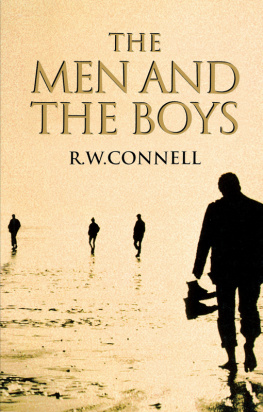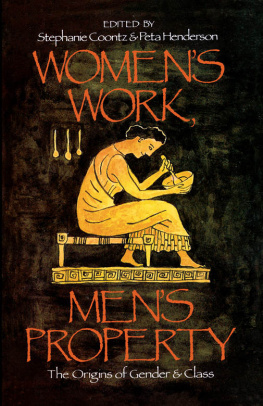Library of Congress Cataloging-in-Publication Data
Names: Barber, Kristen, author.
Title: Styling masculinity : gender, class, and inequality in the mens grooming industry / Kristen Barber.
Description: New Brunswick, New Jersey : Rutgers University Press, 2016. | Includes bibliographical references and index.
Identifiers: LCCN 2015042936| ISBN 9780813565606 (hardcover : alk. paper) | ISBN 9780813565521 (pbk. : alk. paper) | ISBN 9780813565613 (e-book web pdf) | ISBN 9780813572659 (e-book)
Subjects: LCSH: Masculine beauty (Aesthetics) | Grooming for men. | Cosmetics for men. | Beauty shops. | Cosmetics industry. | Sex role.
Classification: LCC HQ1090.27 .B37 2016 | DDC 646.7/044dc23
LC record available at http://lccn.loc.gov/2015042936
A British Cataloging-in-Publication record for this book is available from the British Library.
Copyright 2016 by Kristen Barber
All rights reserved
No part of this book may be reproduced or utilized in any form or by any means, electronic or mechanical, or by any information storage and retrieval system, without written permission from the publisher. Please contact Rutgers University Press, 106 Somerset Street, New Brunswick, NJ 08901. The only exception to this prohibition is fair use as defined by U.S. copyright law.
Visit our website: http://rutgerspress.rutgers.edu
Brylcreem, a little dabll do ya,
Brylcreem, youll look so debonair.
Brylcreem, the galsll all pursue ya,
Theyll love to get their fingers in your hair.
1950s TV jingle for Brylcreem hair pomade
My dad was a stunt pilot. Born in 1925, he began his career crop dusting and was part of the barnstormer era with open cockpits and bi-wing planes. When I was a child I knew him as the center of a group of local airshow performers who traveled the country dazzling audiences of thousands with their death-defying tricks. These were real men. They worked in dirty airplane hangars, and in their younger years some had girlfriends in several cities. I thought back to this group of men as I began my research on men and beauty, especially to my father. I thought about how my brother and I used to play in his relic of a 1950s vibrating exercise machine, an olive green upright mechanism with a wide strap attached to it. The strap wrapped around your waist, hips, or buttocks and was supposed to jiggle the fat off you. I remembered stories of my dad dipping into womens hair dye and moisturizers. One time, preparing for a television interview, he ran a greasy glob of Brylcreem through his hair and down his face. My mom recalls that it was difficult to see him on television since the camera lights created an impossible glare on his slick face. He loyally purchased English Leather cologne from the drugstore, which was known to be a bit more stylish than Brute or Aqua Velva. So, was my dad a metrosexual? By todays standards, not a chance. Yet his participation in the mens grooming market, as limited as it was in the mid- to late-twentieth century, hints that it is a mistake to think of men as nonparticipants in the beauty industryeven those men who lived in a pre-metrosexual era and who we might think of as too masculine to care about their appearances.
The rise of the metrosexual in the mid-1990s injected the idea of a well-groomed, image-conscious, and brand-obsessed straight man into public discourse. And when I began doctoral work at the University of Southern California, newspaper journalists for the New York Times and Chicago Tribune were documenting mens forays into nail salons and designer clothing stores.
In an effort to move beyond both popular and scholarly assumptions about the meaning of mens beauty, I designed a study that focused on the This was my first attempt to observe firsthand mens participation in beauty, and I was able to sit down and interview them about how and why they became loyal clients of the salon. These mostly white, well-to-do men paid for a haircut three times the cost of what they could get at the barbershop down the road, and they ventured into an otherwise feminine space with pink walls, cookie platters, flower arrangements, and a majority of women. They made sense of this gender-boundary crossing by focusing on the importance of professional-looking and stylish hair, as well as on the friendships they believed they had built with the women stylists. They reinforced classed differences between themselves and working-class white men, who they claimed simply did not care enough about their appearances to patronize such places. Their purchase of commercial beauty services did not result in gender equity, as Bordo might suggest, so much as it reinforced hierarchical differences between men along the lines of race and class.
While this research focused on clients, a group interview with three of the salons stylists sparked my interest in the labor that supported the mens narratives. I was especially intrigued by the disparities between mens consumer experiences and womens work experiencessince these experiences arise simultaneously. The men at Shear Style, for example, described their stylists as important people in their lives. The women confirmed that they indeed developed affection for some of their clients, but their stories of working on men emphasized the labor involved in cultivating friendly relationships with clients. They knew clients loyaltyand the size of their tipshung on their ability to create esteem-building relationships with the men in their chairs. They also complained about the men behind closed doors, exasperated that balding men brought in magazine clippings of well-coiffed celebrities like Brad Pitt as inspirations for their own haircuts.
Mens commercial grooming has flourished since the days my father secretly dipped into my mothers creams and purchased cologne at the drugstore. Mens grooming now constitutes a large, visible subsector of the beauty industry and with it, products for men and new service work opportunities have proliferated. A mainly female workforce of hairstylists, estheticians, nail technicians, and cosmetic counter sales associates mediate mens relationships with beauty. They work tirelessly to sell men products, to educate them on the importance of maintaining and improving their appearances, and to provide them with a particular consumer experience. Yet these women are missing from scholarly research. As I designed the study for this book, I wanted to know how working with male clients influences the occupational responsibilities, satisfaction, and identities of these women. I asked: How does gender impact the interactions between women beauty workers and their male clients? What is the role of class, sexuality, and race in spaces dedicated to mens grooming, and how do these structures inform client privileges and worker obligations? What do women like about working in these places and working with and on the bodies of men? What would they change? And how do corporations sell beauty to men in the first place?
I explore these questions in this book. Looking closely at two high-service mens salons in Southern California, Adonis and The Executive, I bring men and the women who groom them into the literature on beauty, service work, consumption, and social inequality. I spent time with the women (and the few men) who work in these places, observed the interactions between workers and clients, and interviewed hairstylists, barbers, nail technicians, receptionists, managers, and a massage therapist, esthetician, shoe shiner, and salon owner about working in mens grooming. What I found was a connection between consumption and service work, where women who labor on mens bodies are integral components of mens beauty experiences. I also found that this labor underpins larger corporate marketing strategies, whereby the historically feminized hair salon becomes a masculine place offering masculinizing services and consumer experiences on the shop floor. This book helps to shine light on a growing consumer trend and a new occupational nichebeauty workers who specialize in mens groomingand is embedded in the historical legacy of mens body projects and the unequal social relations that make these projects possible. While I use a case study of mens salons to discuss the social character and politics of beauty, bodies, and gender relationships, this work has implications for better understanding the complexities and contradictions of work and consumption in the service industry more generally.








